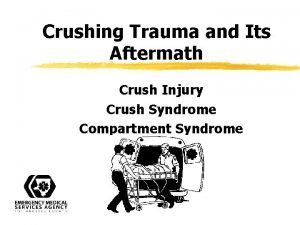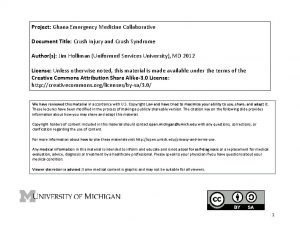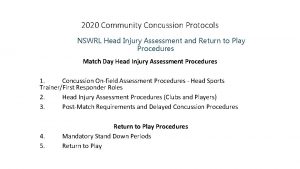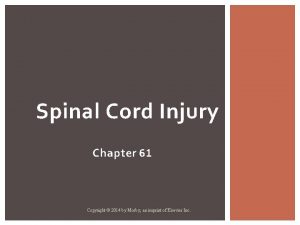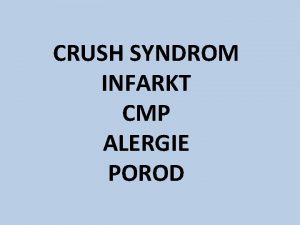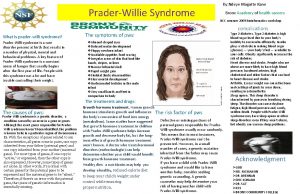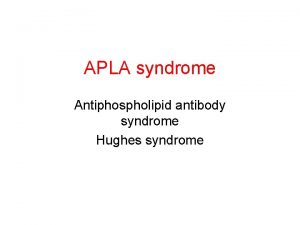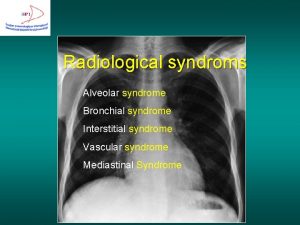Crush Injury and Crush Syndrome Dr S Pezeshki






































- Slides: 38

Crush Injury and Crush Syndrome Dr. S. Pezeshki Orthopedist Azad university of Tehran Medical Branch

History World War One: Meyer-Betz Syndrome Noted in extricated soldiers Triad of: muscle pain weakness brown urine

Bywaters’ Syndrome • • Battle of Britain, May 1941 Multiple subjects Trapped for 3 -4 hours Then developed: • Shock • Swollen Extremities • Dark Urine • Survived Renal Failure Died of Uremia

Epidemiology Earthquakes Bombings Structural Collapse Road crush Trench Collapse “Down and Out”

Definition • compression of extremities or other parts of the body that causes muscle swelling and/or neurological disturbances in the affected areas of the body • Typically affected areas of the body include lower extremities (74%), upper extremities (10%), and trunk (9%).

Functional Definition Any injury that has: 1. Involvement of Muscle Mass 2. Prolonged Compression Usually 4 -6 hours 3. Compromised local circulation

Crush Epidemiology Earthquake Victims 3 -20% of all victims Number of limbs affects risk 1 Limb 50% 2 Limbs 75% >3 Limbs 100%

Crush syndrome is localized crush injury with systemic manifestations. traumatic rhabdomyolysis (muscle breakdown) release of potentially toxic muscle cell components and electrolytes into the circulatory system. • approximately 50% of those with crush syndrome developing acute renal failure • 50% need dialysis

Clinical Presentation Sudden release of a crushed extremity may result in reperfusion syndrome == acute hypovolemia and metabolic abnormalities == lethal cardiac arrhythmias myoglobinuria == renal failure

Hypovolemia Blood and fluid sequestration(up to 12 L) Acidosis Shock and ARF release of nuclear acids and amino acids and lactic acid Metabolite imbalance Hyperkalemia , hypocalcemia , hyperphosphatemia Arrhythmia

Kobe, 1995 372 crush syndrome 202 developed ARF 78 required Hemodialysis Aggressive Fluid Management

Limb Compression Myoglobinemia • Local Pressure • Local Tamponade • Muscle necrosis • Capillary necrosis • Edema Muscle Ischemia Muscle Infarction Extracellular Fluid Shifts ARF SHOCK Acidosis & Hyperkalemia Cardiac Arrhythmia

Limb Compression Myoglobinemia • Local Pressure • Local Tamponade • Muscle necrosis • Capillary necrosis • Edema Muscle Ischemia Muscle Infarction Extracellular Fluid Shifts ARF SHOCK Acidosis & Hyperkalemia Cardiac Arrhythmia

Acute Renal Failure • Myoglobin • Brown urine • p. H • Volume Status • Acids • Renal Effects? • Myoglobin Gel • Distal tubules • Oliguric Renal Failure • Electrolyte Abnormalities • Within 3 -7 days postextrication

ARF Treatment • Aggressive Hydration • In situ IVF • GOAL: • UOP: 200 -300 cc (2 cc/kg/hr) • Alkalinization of Urine • 1 st: Bicarbonate • 2 nd: Acetazolamide • GOAL: • Urine p. H b/w 6 -7 • Forced Diuresis • Lasix • Mannitol

Limb Compression Myoglobinemia • Local Pressure • Local Tamponade • Muscle necrosis • Capillary necrosis • Edema Muscle Ischemia Muscle Infarction Extracellular Fluid Shifts ARF SHOCK Acidosis & Hyperkalemia Cardiac Arrhythmia

Shock • Hypovolemic Shock • >12 L can sequester in the area of crush injury • Study by Oda • Annals of EM, 1997 • Kobe, 1995 • Most commom cause of death (66%) in the 1 st 4 days

Shock Treatment • Early Aggressive Resuscitation • • IVF Blood Products Other products? Close Monitoring • Oral Rehydration • Not so good… • IV Access • Peripheral • Central • Intraosseus • Bolus Therapy • 250 cc aliquots • Titrate to radial pulses and/or UOP

Limb Compression Myoglobinemia • Local Pressure • Local Tamponade • Muscle necrosis • Capillary necrosis • Edema Muscle Ischemia Muscle Infarction Extracellular Fluid Shifts ARF SHOCK Acidosis & Hyperkalemia Cardiac Arrhythmia

Dysrhythmia • Hyperkalemia • Hypocalcemia • Acidosis

Hyperkalemia • Mild (5. 5 -6. 5 m. Eq/L) • Severe (7. 5 -8. 5 m. Eq/L) • peaked T waves • Widening of the QRS • Moderate (6. 5 -7. 5 m. Eq/L) • prolonged PR interval • decreased P wave amplitude • depression or elevation of ST segment • slight widening of QRS • bundle branch • intraventricular blocks • Flat and Wide P waves • AV Blocks • ventricular ectopy • Life-threatening (>8. 5 m. Eq/L) • • loss of P waves High-grade AV blocks Ventricular dysrhythmias Widening of the QRS complex • eventually forming a sinusoid pattern.

Now, what do you see? Peaked T wave

What K is this? Widening of the QRS bundle branch intraventricular blocks Flat and Wide P waves AV Blocks ventricular ectopy

Describe the ECG. loss of P waves High-grade AV blocks Ventricular dysrhythmias Widening of the QRS complex eventually forming a sinusoid pattern.

Management • What are your management options?

Management • Alkalinization • Bicarbonate • Acetazolamide • Calcium • Ca Gluconate • Ca Chloride • Beta-Agonists • Albuterol, etc. • Insulin/Glucose • Potassium Binding Resins • Kayexalate • Surgery: compartment release

Hypocalcemia • Signs • Chvostek’s • Trousseau’s • Tetany • Seizures • Hypotension • ECG Changes • Bradycardia • arrhythmias • Long QT segment

Treatment? • Implications of Hyperphosphatemia? • Metastatic calicification • Rebound hypercalcemia • Treat only if symptomatic.

Acidosis • Myocardial Irritability • Precipitates Arrhythmia • May be refractory to treatment • Treatment already discussed

In Situ Management Prehospital setting: • Patient Access • IV Access • Administer intravenous fluids before releasing the crushed body part. (This step is especially important in cases of prolonged crush [>4 hours]; however, crush syndrome can occur in crush scenarios of <1 hour) • If this procedure is not possible, consider shortterm use of a tourniquet on the affected limb until intravenous (IV) hydration can be initiated • IV Hydration • Bicarbonate • Mannitol • Extrication

Post-Extrication Hospital setting: • Hypotension • Initiate (or continue) IV hydration—up to 1. 5 L/hour • Renal Failure • Prevent renal failure with appropriate hydration, using IV fluids and mannitol to maintain diuresis of at least 300 cc/hr Triage to hemodialysis as needed

Metabolic Abnormalities • Acidosis: Alkalinization of urine is critical; administer IV sodium bicarbonate until urine p. H reaches 6. 5 to prevent myoglobin and uric acid deposition in kidneys • Hyperkalemia /Hypocalcemia: • calcium gluconate 10% 10 cc or calcium chloride 10% 5 cc IV over 2 minutes • sodium bicarbonate 1 meq/kg IV slow push • regular insulin 5 -10 U and D 5 O 1 -2 ampules IV bolus • kayexalate 25 -50 g with sorbitol 20% 100 m. L PO or PR

Secondary Complications • Monitor casualties for compartment syndrome; monitor compartmental pressure if equipment is available; consider emergency fasciotomy for compartment syndrome • Treat open wounds with antibiotics and tetanus toxoid, and debridement of necrotic tissue • Apply ice to injured areas and monitor for the 5 P’s: pain, pallor, parasthesias, pain with passive movement, and pulselessness • Observe all crush casualties, even those who look well

Disposition • Patients with acute renal failure may require up to 60 days of dialysis treatment; unless sepsis is present, patients are likely to regain normal kidney function

Delayed Causes of Death • • • ARF ARDS Sepsis Ischemic Organ Injury DIC Electrolyte Disturbances

Advances in Management In situ fluid resuscitation Israel, 1982 1/8 developed ARF Aggressive Fluid Resuscitation, postextrication Japan, 1995

Advances in Management • Disaster Relief Task Force • Marmara, Turkey • Task Force: • Trained Personnel • Portable HD • 462 ARF (18% mortality)

 Dr maryam ghasemi
Dr maryam ghasemi How to protect yourself from intentional injuries
How to protect yourself from intentional injuries Crush syndrome
Crush syndrome Bywaters syndrome
Bywaters syndrome Crush syndrome
Crush syndrome What is katniss’ prediction as she readies herself?
What is katniss’ prediction as she readies herself? Candy crush 5084
Candy crush 5084 Candy crush 4248
Candy crush 4248 Fasiyotomi
Fasiyotomi Crush seal design
Crush seal design Cadbury beverages
Cadbury beverages Email candy crush
Email candy crush Dk crush technique steps
Dk crush technique steps Reverse crush technique
Reverse crush technique Candy crush betting
Candy crush betting Pushing down on me
Pushing down on me Candy crush demographics
Candy crush demographics Dk crush technique
Dk crush technique Curtiss stinis md
Curtiss stinis md Math project grade 7
Math project grade 7 Labyrinth seal design guidelines
Labyrinth seal design guidelines Dk crush technique
Dk crush technique Air pressure clipart
Air pressure clipart Candy crush 1830
Candy crush 1830 Infatuation vs love
Infatuation vs love Aim high dream big
Aim high dream big Dk crush technique
Dk crush technique Title crush
Title crush Vertical
Vertical Injuries first aid
Injuries first aid The sad persons scale
The sad persons scale A spill at parsenn bowl: knee injury and recovery
A spill at parsenn bowl: knee injury and recovery Nrl head injury recognition and referral form
Nrl head injury recognition and referral form Cell injury and inflammation
Cell injury and inflammation Cell injury and inflammation
Cell injury and inflammation Serious injury and fatality prevention
Serious injury and fatality prevention Flipchart on safety practices and sports injury management
Flipchart on safety practices and sports injury management Unintentional injury examples
Unintentional injury examples Somi brace
Somi brace


